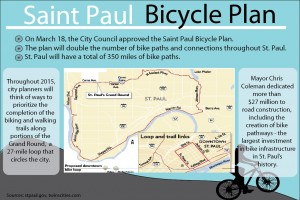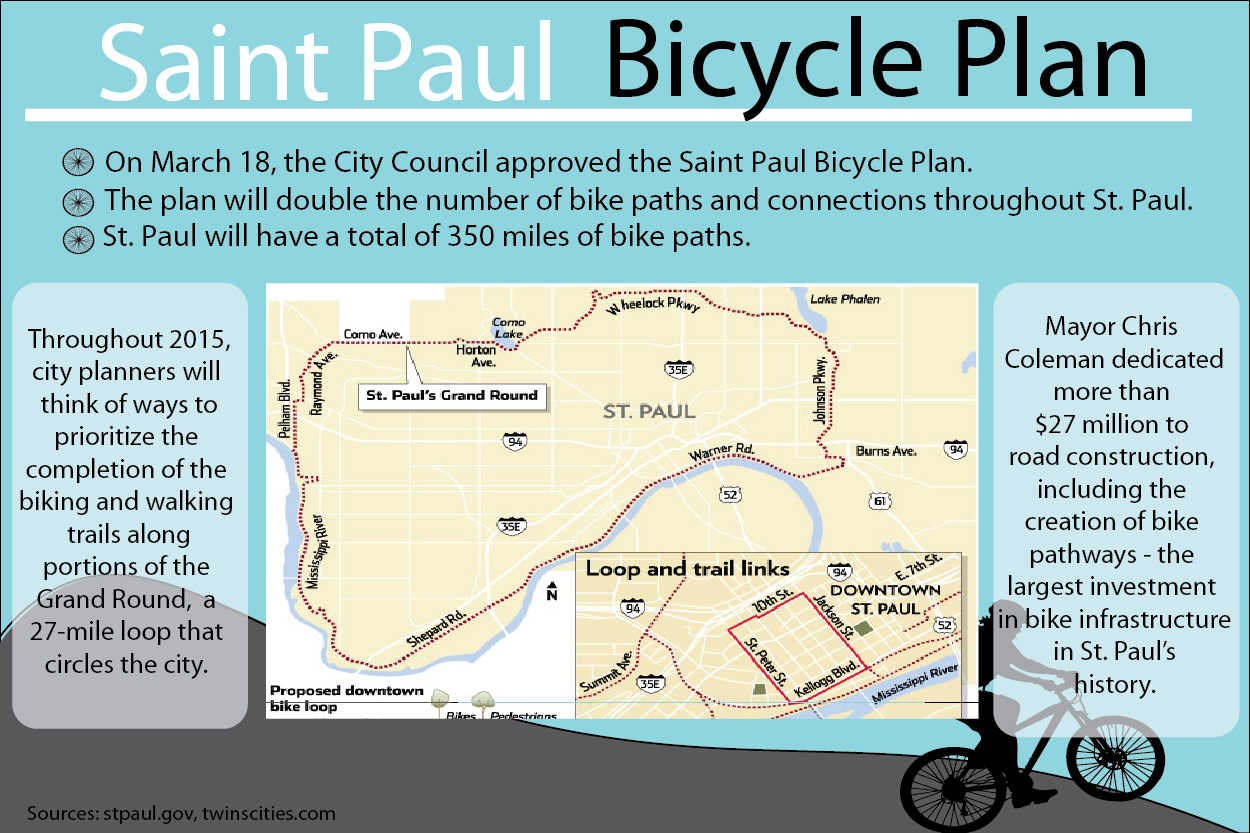
Junior Jack Hiniker’s preferred method of transportation is the bicycle. Hiniker isn’t just a casual rider – the kind of cyclist who bikes around the lake on weekends; he bikes six days a week, logging more than 300 miles as part of an Olympic development triathlon training program.
Hiniker commutes and trains in and around the Twin Cities and said he sees a drastic difference between biking in St. Paul versus in Minneapolis – something the St. Paul City Council has also noticed.
Last month, the city council adopted the Saint Paul Bicycle Plan, which will more than double bike pathways and connections throughout the city over the next several decades. For Hiniker, this is a welcome improvement.
“Minneapolis has a really good system right now, hundreds of miles,” Hiniker said. “St. Paul really lacks, but I think this new trail is going to really draw people into the St. Paul area.”
The plan is the largest bike infrastructure development in the city’s history. It calls for the construction of 197 additional miles of bicycle facilities, bringing the total bicycle network to 350 miles within St. Paul. The plan started taking shape in 2011 and is now funded as part of St. Paul Mayor Chris Coleman’s $27 million road construction plan.
This undertaking, Coleman said in a press release, will not only improve city infrastructure but improve safety for bikers.
“St. Paul needs to be a city that works for everyone, whether they are age eight or age 80 – and whether they are traveling by foot, car, transit or bicycle,” Coleman said in the press release. “This long-term, comprehensive bike plan will transform our neighborhoods over time by helping to ensure a balanced and equitable approach to transportation infrastructure, improved safety and quality of life, and new economic opportunities and access for people of all ages.”
The safer bike routes are something Hiniker is excited to see since bikers frequently have to ride alongside cars.
“With this trail network, it’s going to be much safer, faster and more efficient to get to places where people want to go,” Hiniker said. “To open up a trail network that goes from St. Thomas to downtown St. Paul and connects to the Minneapolis trail network safely – that just opens a world of opportunities for cyclists at St. Thomas.”
Urban designer Gil Penalosa’s work influenced the plan, which includes the completion of the scenic Grand Round loop around the city. Hiniker believes these additions will make biking safer and improve the quality of life in St. Paul.
“If you look at quality of life, one thing that factors into that is how healthy your lifestyle is and if you’re active or not,” Hiniker said. “In Minneapolis, you see hundreds of people commuting to work on their bikes using the commuter trails. If you have that same safe, available, healthy transit system going in St. Paul, it’s really going to contribute to improving the quality of life.”
The bike path additions are expected to take more than a decade to complete, but Hiniker believes that given the long-term value, the wait is worth it.
“We still have a long ways to go,” Hiniker said. “Minneapolis is doing a great job, but it’s time for St. Paul to start kicking in with a unified system. St. Paul’s a beautiful city, and to expand the trail network here only makes sense.”
Simeon Lancaster can be reached at lanc4637@stthomas.edu.



